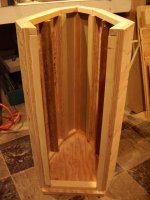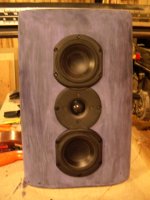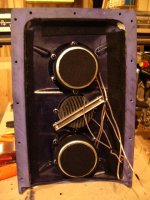I personally think there's an awful lot of overkill in some of the proposals I've read here.
Overkill in DIY Audio? Say it ain't so!
David
I personally think there's an awful lot of overkill in some of the proposals I've read here.
overkill? don't we all want to build the best possible loudspeaker?
Hello,
I do not remember the degree of stink from Henry 107, it is water based and low VOC. Typically low VOC means reduced smell.
An alternate flooring material is 12x12 VCT tile. Left over partial boxes in the back of the store are not expensive But then there is the low VOC adhesive to deal with.
Vinyl Composition Tile (VCT) from Carpet Express
DT
All just for fun!
I do not remember the degree of stink from Henry 107, it is water based and low VOC. Typically low VOC means reduced smell.
An alternate flooring material is 12x12 VCT tile. Left over partial boxes in the back of the store are not expensive But then there is the low VOC adhesive to deal with.
Vinyl Composition Tile (VCT) from Carpet Express
DT
All just for fun!
I don't understand all this terminology, what's this "overkill" thing?
When much too much is just about enough!
David
Ok, now you guys are just going around in circles. if you want to damp a panel, intersect it with a brace at 1/2 and 1/4 to raise the resonance above audible resonance energies of the material... or staple some floppy mass to it (rubber, roofing tarpaper, upholstery vinyl, whatever).
or keep going, complexity is good maybe y'all will figure out quantum entanglement.
or keep going, complexity is good maybe y'all will figure out quantum entanglement.
So now there is speculation that adding mass without stiffness is appropriate. So why the obsession with BB ply with no voids? Seems to me that plywood WITH voids is a good solution. A void in a panel will do two things: decrease stiffness while adding mass; and randomly divide panels into smaller sections, which will also raise resonance frequency.
I just finished building bass bins for my actively bi-amped setup. The panels are two layers of ply glued and nailed together: the inner is 3/4" crappy CDX grade, full of knots and voids. I filled some of the voids by inserting small pieces of thin wood coated with glue. The outer layer is better 1/2" ply. Walls are damped with 1/2" wool felt. The bottoms are filled with 2" of very rough finish concrete. The top panels, which support the mid/tweeter enclosures, are attached only with a layer of silicone caulk. The baffles are two layers of 3/4" ply, glued together.
I'm sure there are resonances, but I don't hear them. Bass is incredibly tight. Here is a pic of one bin, early in construction.
Peace,
Tom E
I just finished building bass bins for my actively bi-amped setup. The panels are two layers of ply glued and nailed together: the inner is 3/4" crappy CDX grade, full of knots and voids. I filled some of the voids by inserting small pieces of thin wood coated with glue. The outer layer is better 1/2" ply. Walls are damped with 1/2" wool felt. The bottoms are filled with 2" of very rough finish concrete. The top panels, which support the mid/tweeter enclosures, are attached only with a layer of silicone caulk. The baffles are two layers of 3/4" ply, glued together.
I'm sure there are resonances, but I don't hear them. Bass is incredibly tight. Here is a pic of one bin, early in construction.
Peace,
Tom E
Attachments
How does a void add mass? It can only add volume.A void in a panel will do two things: decrease stiffness while adding mass
That enclosure does look impressively solid. Am I seeing 6 panels + baffle there?
I should have been more clear. The panel adds mass, while the void in a panel of ply decreases stiffness. Although, I must admit that I don't believe small voids really decrease stiffness all that much. I'm not sure BB ply is all it's cracked-up to be. No apologies for the pun.
As I wrote in the previous post, I think voids may actually serve to break panels randomly into smaller sections. I am more concerned about loose bits inside voids rattling around. That's why I stuffed most of them with glue-coated sticks, pushed or pounded in as far as they would go, usually all the way through. Most voids are pretty straight, and the thickness of a single ply.
I should also take better pictures, and more of them. Yes, it's six sides plus the baffle. Only the top and bottom are parallel, and the bottom is covered with 2" of rough-finished concrete, sloped from thin at the front to thick at the back so even those aren't really parallel. The inside of the top is covered with Deflex material. Four of the six panels are quite narrow (4-6" wide), while the biggest two are about 10" wide, still small by bass bin standards. Mating edges of ply are mitered, with matching angle solid wood ribs glued and screwed into each joint. This is NOT a beginner's woodworking project.
Peace,
Tom E
As I wrote in the previous post, I think voids may actually serve to break panels randomly into smaller sections. I am more concerned about loose bits inside voids rattling around. That's why I stuffed most of them with glue-coated sticks, pushed or pounded in as far as they would go, usually all the way through. Most voids are pretty straight, and the thickness of a single ply.
I should also take better pictures, and more of them. Yes, it's six sides plus the baffle. Only the top and bottom are parallel, and the bottom is covered with 2" of rough-finished concrete, sloped from thin at the front to thick at the back so even those aren't really parallel. The inside of the top is covered with Deflex material. Four of the six panels are quite narrow (4-6" wide), while the biggest two are about 10" wide, still small by bass bin standards. Mating edges of ply are mitered, with matching angle solid wood ribs glued and screwed into each joint. This is NOT a beginner's woodworking project.
Peace,
Tom E
I'm not sure BB ply is all it's cracked-up to be.
If you've never used it, how would you know?
jeff
Uh, can you please explain what your comment adds to the discussion here?
I have used BB, and all kinds of other materials. I've been building speakers for more than 40 years. My dad built speakers before that. I know that doesn't make me an expert. Most of my education in physics and engineering is self-taught. Some of this stuff is an art, some of it is science. I think I have mastered a portion of the art stuff, and I'm learning a lot here about the science part, but not from comments like yours.
I wrote that BB MIGHT not be as great as many DIY posters claim. Some seem almost obsessed with it. It's better than MDF in many ways, but maybe cheaper plywood of lesser grades is also good enough. I'm offering a proposition here, not proclaiming anything. I bet there are smarter people who can explain whether crummy ply is really no good, but my own experience with this particular enclosure is that it serves very well when laminated to another, higher grade, which together might even be better than two layers of high grade, high cost BB.
Peace,
Tom E
I have used BB, and all kinds of other materials. I've been building speakers for more than 40 years. My dad built speakers before that. I know that doesn't make me an expert. Most of my education in physics and engineering is self-taught. Some of this stuff is an art, some of it is science. I think I have mastered a portion of the art stuff, and I'm learning a lot here about the science part, but not from comments like yours.
I wrote that BB MIGHT not be as great as many DIY posters claim. Some seem almost obsessed with it. It's better than MDF in many ways, but maybe cheaper plywood of lesser grades is also good enough. I'm offering a proposition here, not proclaiming anything. I bet there are smarter people who can explain whether crummy ply is really no good, but my own experience with this particular enclosure is that it serves very well when laminated to another, higher grade, which together might even be better than two layers of high grade, high cost BB.
Peace,
Tom E
I have used BB, and all kinds of other materials. I've been building speakers for more than 40 years. My dad built speakers before that. I know that doesn't make me an expert. Most of my education in physics and engineering is self-taught. Some of this stuff is an art, some of it is science. I think I have mastered a portion of the art stuff, and I'm learning a lot here about the science part, but not from comments like yours.
My comment wasn't meant to be insulting. I'm curious why you don't like BB, from a material (attributes) point of view, or where you used it with success?
jeff
Okay, now I understand. Sorry I went off there.
I do like BB ply. I like all ply, although I've used MDF and even particle board. Sometimes I've combined two types, alternating panels in the same enclosure, or laminating one over the other. But BB is expensive, and I'm not sure it's always necessary to go to that expense to get the best performance. I don't have any hard data that shows any material is superior to another, but I can say more rigid walls, especially different materials laminated to be thicker, seem to sound better.
I don't think ringing materials such as metal or stone are suitable unless extraordinary damping methods are used. To me that seems to be too much work.
In order to achieve a unique profile that would have been difficult to execute with wood, my latest project employs molded polyurethane for the baffle of the mid/tweet enclosures, and that seems to have worked out pretty well.
Peace,
Tom E
I do like BB ply. I like all ply, although I've used MDF and even particle board. Sometimes I've combined two types, alternating panels in the same enclosure, or laminating one over the other. But BB is expensive, and I'm not sure it's always necessary to go to that expense to get the best performance. I don't have any hard data that shows any material is superior to another, but I can say more rigid walls, especially different materials laminated to be thicker, seem to sound better.
I don't think ringing materials such as metal or stone are suitable unless extraordinary damping methods are used. To me that seems to be too much work.
In order to achieve a unique profile that would have been difficult to execute with wood, my latest project employs molded polyurethane for the baffle of the mid/tweet enclosures, and that seems to have worked out pretty well.
Peace,
Tom E
Attachments
In order to achieve a unique profile that would have been difficult to execute with wood, my latest project employs molded polyurethane for the baffle of the mid/tweet enclosures, and that seems to have worked out pretty well.
Peace,
Tom E
Ive considered doing something like this using casting polyester resin, the idea of making a near perfect mould seems a little daunting to me. nice work!
- Status
- This old topic is closed. If you want to reopen this topic, contact a moderator using the "Report Post" button.
- Home
- Loudspeakers
- Multi-Way
- What are the characteristics of a better material for enclosure?


